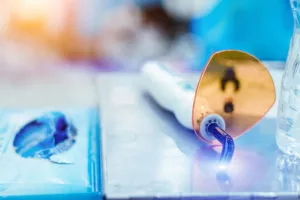Composite restorations are an important weapon in the dental arsenal—and both the science and the technology have come a long way.
By Howard Strassler, DMD
THINGS AREN’T ALWAYS as they appear, in dentistry just as in life. Most composite resins seem to be the same, and most light-curing devices seem bright enough to cure most composite resins. Significant differences abound, though. It’s important, when choosing your materials and equipment, to understand the chemistry of composite resins and your curing light’s ability to adequately polymerize them. That way lie successful restorations.
Some basics: The majority of composite resins comprise a resin-based oligomer polymer matrix with embedded glass fillers that are pretreated with organosilanes so they’ll chemically adhere to the bisphenol A-glycidil methacrylate or urethane dimethacrylate resin matrix. For most direct-placement composite res- ins, polymerization is mediated by light-sensitive photoinitiators.
Today’s composites predominantly employ camphoroquinone (CQ), which is sensitive to predominantly blue light (with a wavelength of about 420 to 480 nanometers). Some manufacturers, however, have enhanced their composites’ ability to light-cure by adding to the mix an additional photoinitiator that is sensitive to the violet spectrum (wavelength ~320–420 nm). These violet-light- sensitive photoinitiators include lucirin (TPO), phenylpropanedione (PPD) and Ivocerin (made by Ivoclar Vivadent), with an extended wavelength of violet to blue (370–460 nm).
Doctors have a variety of options when selecting a light-curing device for composite resins. This wasn’t always so: The first light-curing units used quartz halogen light sources that emitted very broad-spectrum light, ranging from violet to red, that would adequately polymerize all composites. Today’s most popular curing lights, by contrast, use high-energy blue LED emitters or a hybrid of blue and violet LED emitters.
When LED curing lights were introduced in the late 1990s, many selected solely blue-wavelength LED emitters, which were able to polymerize composites using CQ to ensure a greater curing depth compared to the earliest UV light-curing devices. The dentist would then have to layer UV-cured composite a single millimeter at a time.
The introduction of CQ as a photoinitiator enabled clinicians to achieve greater curing depth, making composite placement with blue-wavelength light-curing devices easy. Some doctors expressed concerns about CQ composites, citing the inherent yellow coloration of the photoinitiator, which lent a yellow tinge to the composite resin before light curing, making it impossible to evaluate shade matching while placing the restoration.
In anterior restorations especially, the composite appeared somewhat yellower than the surrounding tooth. Fortunately, though, in most cases, once light-cured the yellow CQ composites bleached to the dentist’s desired hue.
To address this shortcoming, a number of manufacturers began to investigate alternative chemistries for light-curing. As a result, several of them started to make limited use of clearer TPO and PPD photoinitiators, which lent the putty-like composite a truer color during placement. One problem with using a violet-wavelength photoinitiator, meanwhile, is the decreased depth of cure that necessitates more layers during placement of the composite resin. To combat this problem, a number of manufacturers formulated composite res- ins with a hybrid of CQ and either TPO or PPD photoinitiators.
Although this marriage of convenience between violet and blue-light photoinitiators improved composite shades, many dentists remained unaware of this hybrid chemistry; most LED curing lights used in dental practices are strictly for curing blue-light-sensitive-based composites.
Such curing devices do not fully polymerize all the chemical components with composites using a combination of CQ and TPO or PPD. Thus Ivoclar developed Ivocerin, a proprietary photoini- tiator that offered the broadest available light-curing spectrum, including violet to blue wavelengths.
It’s critical that all clinicians know whether the composite resin they’re using is matched to their light-curing device. In addition to Ivoclar, several companies have now developed curing lights with that broader light spectrum. They’re called polywave curing lights, and they en- sure complete photopolymerization of all photoinitiator chemistries within a broad group of composite resins.
In addition to the materials you use, of course, there are several key factors to successful, long-lasting composite-resin restorations:
- Match composite resin to curing light. CQ-photoinitiated composites require blue-wavelength curing lights; TPO/PPD-CQ-photoinitiated composites require polywave lights; Ivocerin-photoinitiated composites can be matched to polywave or blue-wavelength curing lights.
- Avoid bargain-basement curing lights. You get what you pay for, after all, and cheap lights won’t deliver stable output as their battery charge decreases. They’re also likely to have uneven hot and cold surface areas, which contributes to undercured composite.
- Position the tip of the curing light at right angles to the surface you’re curing. You might have to move the light tip somewhat to overlap large areas of the surface.
- Stabilize the light tip while curing.
- Use a blue-blocking shield on the light tip, or wear blue-blocking glasses with orange lenses.
- Choose an LED curing light with an irradiance value of at least 1000 mW/cm2.
- Using a radiometer, monitor the light output of your curing light regularly.
- Air-cool the tooth and restoration during the light-curing process, or wait several seconds between each curing cycle.
Practicing dentistry is about making educated decisions. With composites and curing lights, be sure the ones you use are matched: same type of photoinitiator, proper irradiance value for polymerization and wavelength of the light being emitted by your curing device.
This information, counterintuitively, might be difficult to find online. Talk to your manufacturer or dealer representative—and in no time your knowledge base will be, pardon the phrase, light years ahead of where it used to be.
HOWARD STRASSLER, DMD is a professor and the director of operative dentistry at the University of Maryland School of Dentistry. He practices in Pikesville, Maryland.
Lighting the Way

SUCCESSFUL SINGLE-tooth restorations depend on a clinician paying great attention to detail. The composite resins and adhesives we have at our disposal are excellent these days—so the amount of light energy you choose for polymerization is a critical decision.
Not all curing lights are comparable when it comes to the variables that matter most. You must decide on your minimal standard for power, irradiance, tip diameter and beam profile, or the amount of energy delivered over the tip diameter.
Although you’re always understandably looking to save time, shorter-duration restoration placement increments might not be the best place to find those savings.
Some manufacturers directly correlate irradiance value and the time to provide a given amount of energy, as expressed in joules. There is no direct correlation, though there is a reciprocity factor: Composites can cure only at a certain specific rate and can go no faster. The higher the irradiance value, too, the more heat will be generated by the procedure—and you certainly don’t want to fry the pulp.
There’s quite a lot to consider when you’re selecting a curing light. Please visit bit.ly/2nuzpNl, and Hints From Howard will help illuminate your best path forward.




